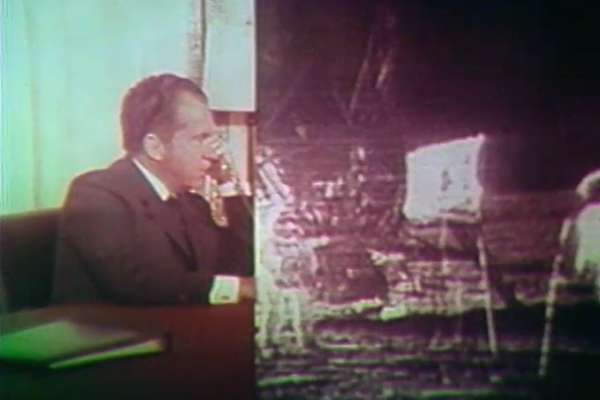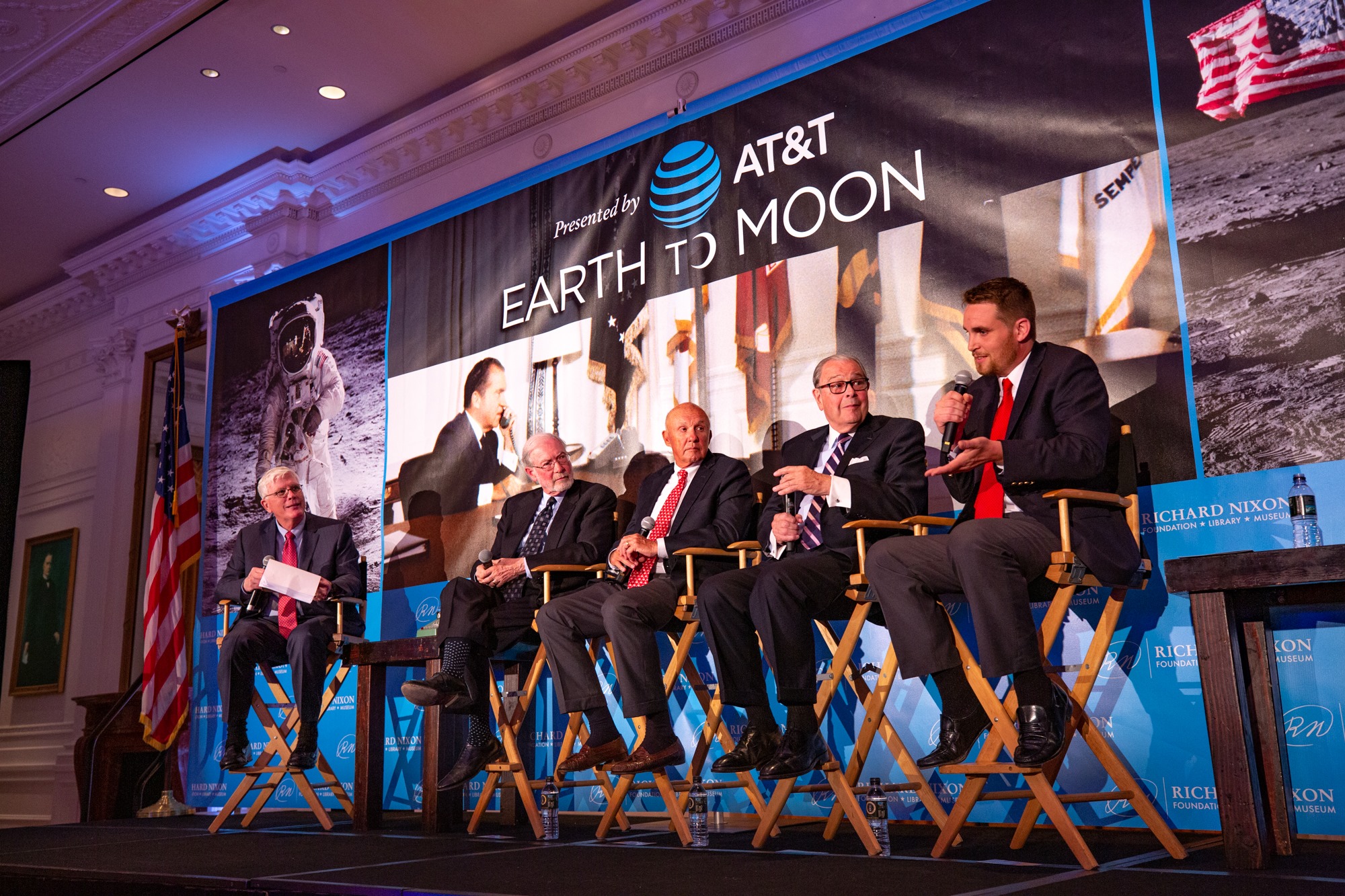(Left to right) Hugh Hewitt, John Price, Larry Higby, Dwight Chapin and Alex Eisenhower discussed the White House events behind the moon landing. (Richard Nixon Foundation)
YORBA LINDA – President Nixon not only viewed America’s moon shot as a Cold War victory, but a symbol of national unity and a global gesture of peace explained top Nixon White House aides in a discussion at the Nixon Presidential Library about their eyewitness account of the 37th president’s Oval Office phone call to the Apollo 11 astronauts.
The program was part of “Earth to Moon” the Library’s 50th anniversary commemoration of the moon landing, presented by AT&T on Saturday, July 20.
Participants included Dwight Chapin, appointments secretary to the president; Larry Higby, assistant to chief-of-staff H.R. Haldeman; John Price, executive secretary to Urban Affairs Council head Daniel Patrick Moynihan; and Alex Eisenhower, the grandson of President Nixon and son of David and Julie Eisenhower. Nixon Foundation President and CEO Hugh Hewitt moderated the program, which was introduced by Rhonda Johnson, CEO of AT&T California.
Johnson discussed AT&T’s role in setting up the historic phone call. She explained how 100 years ago Alexander Graham Bell made the first intercontinental phone call over 3,000 miles. Fifty years later President Nixon made a phone call 240,000 miles through the solar system.
The panelists talked the political context of the space race, and the events in the White House during that historical day. Hewitt put the discussion to a hard stop at 8:48pm (PT), and queued up President Nixon’s phone call to Neil Armstrong and Buzz Aldrin in real time, 50 years to the minute.
The space race began in 1957 when the Soviet Union launched their first satellite Sputnik in October that year.
“It was a slap in the face to American complacency,” explained Price, a graduate of Grinnell College in central Iowa.
One evening, shortly after the launch, Price ventured out with a friend to a corn field and gazed at the satellite with a naked eye.
Awed by his experience, he phoned to tell his grandmother, the wife of an Iowa dairy farmer.
“Not possible,” she said. “God wouldn’t allow it.”
Chapin said that it was President Kennedy who united America behind the common goal of winning the space race.
“President Nixon was behind it one thousand percent,” Chapin said of Kennedy’s long time political rival. “He thought Kennedy made the right decision.”
The space program had always been considered for the chopping block in favor of more immediate domestic political considerations. By the mid-1960s, it had peaked to over four percent of the total federal budget.
Chapin further explained, in that year then candidate Nixon contested budget cuts to the space program, calling its funding a national imperative if America was to stay competitive with the Soviet Union.
Nixon also saw the space program as a way to bolster the national spirit. Case in point was President Nixon’s inaugural address, six months to the day before the moon landing on January 20, 1969.
By the time Nixon took office, the nation was deeply divided along racial, cultural and generational lines. The Vietnam War was at its height. In 1968, there were 125 urban riots across the country which resulted in hundreds of casualties, and millions of dollars in property damage.
Nixon used the imagery of man’s rendezvous with space as a way to communicate the idea of national unity.
“Only a short few weeks ago, we shared the glory of man’s first sight of the world as God sees it, as a single sphere reflecting light in the darkness,” Nixon said, recalling the Apollo 8 mission on Christmas Eve 1968.
Reciting Archibald MacLeish’s inspired poem, Nixon said that to see the Earth in its silence where it floats, “is to see ourselves as riders on the earth together, brothers on that bright loveliness in the eternal cold — brothers who know now they are truly brothers.”
“Nixon had an uncanny sense of timing,” Higby explained. “He invoked the moon more than once in this regard.”
Nixon forged a friendship with Apollo 8 commander Frank Borman, who would become the president’s chief advisor and liaison to the space program.
Borman was the only person to watch the launch with President Nixon. During a special church service on the day of the moon landing officiated by a quaker minister from his alma mater Whittier College, Nixon asked Borman to read from Genesis, just as he did on an international broadcast during the Apollo 8 mission.
John Price was the only one of the panelists at the launch in Cape Kennedy on July 16. Vice President Agnew represented President Nixon. The President also arranged for Air Force 1 to carry former President Lyndon Johnson — a staunch supporter of the space program — to Florida.
Price flew with the vice president’s delegation. He was seated next to Jean Sainteny, a former Gaullist cabinet minister, on Air Force 2. Sainteny had been invited on the basis of his position as director of Air France.
This would later prove to be a cover. The real reason for Sainteny’s visit, Price explained, was to act as an intermediary between the president and North Vietnam’s leader Ho Chi Minh. Months later, negotiations between Dr. Kissinger and the North Vietnamese would commence, the first of which took place in Sainteny’s Paris apartment.
Back at the White House, Chapin and Higby were working with the president’s chief-of-staff Bob Haldeman on the arraignments for the telephone call.
Chapin illustrated this to the audience though the projection of silent footage he captured on his Super 8 camera — which he frequently used to film historic events during the course of the administration.
He and Higby explained that the White House was in a state of “hurry up and wait” the evening of July 20.
Recently, the events in the White House have been dramatized by news stories which recycled a memorandum speech writer William Safire wrote to Haldeman, entitled “In event of a moon disaster.”
The memo detailed what Nixon might say if the astronauts died during the mission.
“I think that memo has received more play within the past 10 days, then the 10 days after it was written 50 years ago,” Chapin recalled. “I don’t recall it ever being mentioned.”
President Nixon watched the moon landing at 4:17pm ET with Borman and Haldeman in the little room off the Oval Office. Chapin, Price and other White House staffers were in the Cabinet Room — watching the television with anticipation and smoking cigars in celebration.
“A roar went up in the Cabinet Room, that would be echoed in bars, living rooms and railroad stations across the country,” Price described the atmosphere when Armstrong set foot on the moon.
The actual phone call wouldn’t take place till more than seven hours later.
Chapin narrated the Super 8 footage of the Cabinet Room, to the president’s eventual arrival in the Oval Office.
Among those captured on film were future Fox News chief Roger Ailes, who served as technical advisor for the broadcast which millions would watch across the world.
Ailes arranged for President Nixon to be presented on television — split screen to appear he was facing the astronauts. Ailes’ queues would come through Borman from NASA.
The participants mentioned that Nixon was thrilled about the occasion, but was focused intensely on making the phone call a success.
Immediately, following the telephone call, Nixon remarked to the camera men, “I’d hate to get the toll charges on that call.”
“Make it collect!” one of them shouted back.
After President Nixon left the Oval Office, he joined First Lady Pat, and daughters Tricia and Julie in the Rose Garden for pictures.
“My mother said the whole event was an electric experience,” Eisenhower said.
 President Nixon made the longest long distance phone call in history, 240,000 miles to the Apollo 11 astronauts on the moon.
President Nixon made the longest long distance phone call in history, 240,000 miles to the Apollo 11 astronauts on the moon.
President Nixon traveled to the South Pacific to greet the astronauts for their return. On July 23 he flew to San Francisco before stopping at Johnston Island. He then took a helicopter to the U.S.S. Arlington where he would stay overnight before boarding the U.S.S. Hornet.
Early morning on July 24, he saw the Command Module Columbia splash down in spectacular fashion. The U.S. Navy band played “Columbia, Gem of the Ocean” as the astronauts arrived on the Hornet.
On the Hornet, the Super 8 camera also captured President Nixon’s conversation with the three astronauts — Armstrong, Aldrin and Michael Collins — while in the mobile quarantine unit. Nixon congratulated them on their heroics, made banter about the Major League Baseball all-star game, and said he would invite them and their spouses to a presidential dinner.
Following the splash down, Nixon stopped for rest in the American protectorate of Guam, where in informal remarks with newsmen, he articulated his foreign policy doctrine on July 25.
Nixon then proceeded on an eight country tour through Asia and Europe, which Chapin characterized in strategic terms.
The trip was not only a way to project American prestige across the world and bask in the accomplishment of the moon landing, but also to reassure allies and make inroads with leaders of countries with which the United States didn’t hold traditional relationships.
This included Romania and Pakistan, who would later be crucial to the strategy of opening lines of communication to the People’s Republic of China, which culminated in President Nixon’s historic trip in February 1972.
Following the president’s return, the administration hosted a dinner for Armstrong, Aldrin and Collins on August 13 in Los Angeles, where they were presented the Presidential Medal of Freedom. This event was the beginning of the astronaut’s global goodwill tour. Hewitt recalled that during one stop in Mexico City, seven million people lined the streets to see them.
“They were the rock stars of the world,” Higby commented.
On November 5, 1969, the astronauts returned to America for a ceremony on the South lawn of the White House, two days after President Nixon gave his address to the nation on the Vietnam War, popularly known as the “Silent Majority” speech.
Asked whether the Apollo mission impacted the silent majority, the panelists response was a resounding yes.
For Higby, it brought the country together despite the divisions over the war.
Price agreed that it was definitely an American moment. Quoting an excerpt of the “Airman’s Sonnet” “(“I’ve trod the high, untrespassed sanctity of space, Put out my hand, and touched the face of God”) he said the event was also a deeply spiritual moment for humanity, those “Riders of the Earth” which President Nixon referred to in his inaugural.
Eisenhower said he always looked at President Nixon as a grandfather, but continues to be amazed about his impact on the world. He said cheerfully, “I didn’t realize his signature is on the moon.”
“The president signed a plaque which the astronauts placed on the moon,” Chapin added.
“It says ‘we come in peace for all mankind.’”

